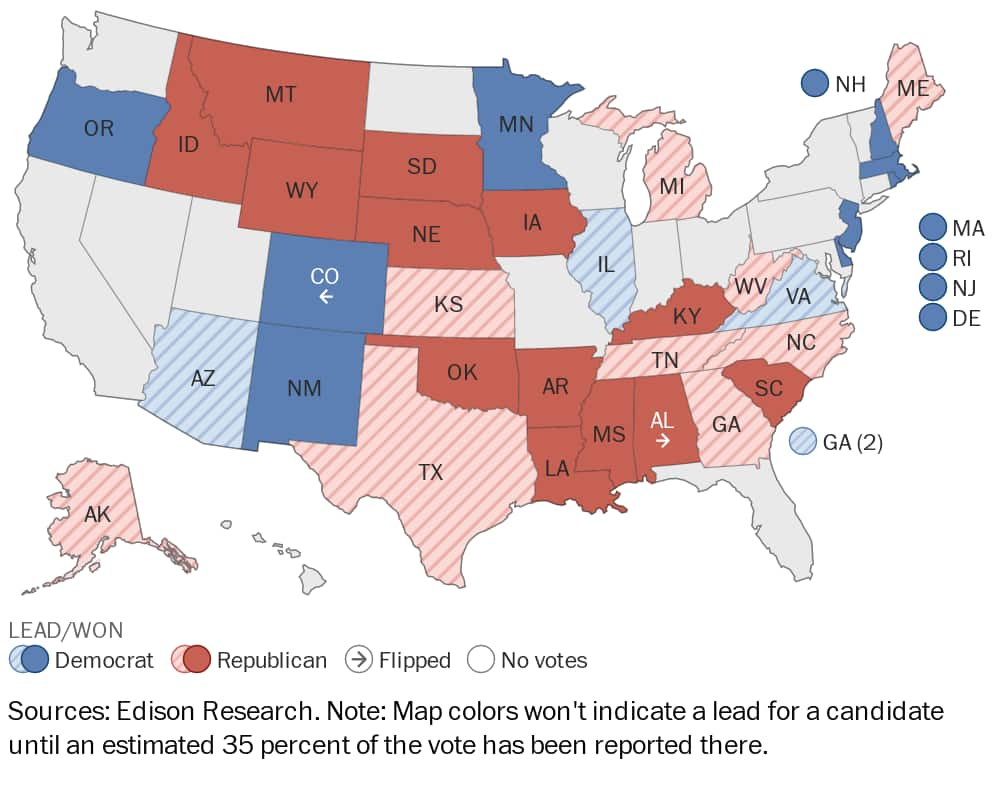Democrats did not have the night they hoped for in the battle for the Senate

On election night, Democrats won one in Colorado by unseating Sen. Cory Gardner (R). But that was immediately offset by Sen. Doug Jones (D) losing in Alabama. Democrats look on track to pick up another seat in Arizona. But that still leaves them at least two seats short.
And with relative ease on election night, Senate Republicans closed Democrats’ path to pick up those seats. Steve Daines (R) held on and won reelection in Montana. Joni Ernst (R) was reelected in Iowa. Those are two toss-up races that Democrats had managed to make competitive with strong candidates and strong fundraising despite the red lean of these states. But they couldn’t get their Democratic candidates over the top.
Longer-shot races for Democrats, like unseating John Cornyn (R) in Texas or Sen. Lindsey O. Graham in South Carolina or even Senate Majority Leader Mitch McConnell (R) in Kentucky also failed, despite Democrats raising hundreds of millions of dollars and breaking fundraising records to try to oust them.
“To all the pollsters out there: You have no idea what you’re doing,” Graham said after winning his race, taunting the massive amounts his Democratic challenger, Jaime Harrison, raised to try to beat him. “And to all the liberals in California and New York, you wasted a lot of money.”
But the races that have really got to concern Democrats are the ones that remain uncalled.
Susan Collins (R) is leading in Maine. So is Sen. Thom Tillis (R) in North Carolina. These two battles are Democrats’ main steppingstones to the majority. Before election night, they were important for Democrats to win. But now that we know Democrats don’t have a cushion in Iowa or Montana, they are absolute must-wins for them.
Early Wednesday morning, Collins is leading by six percentage points, thanks to what Senate Republican strategists say was a late-surge in Maine’s more conservative areas to keep her in office. That could be enough of a cushion to help her avoid multiple rounds of re-tabulations of the vote under Maine’s unique ranked-choice voting system, which awards second-choice votes to the top vote-getters if no candidate gets over 50 percent of the vote. (Votes are still outstanding, and it’s unclear if Collins has 50 percent, but she’s close.)
In North Carolina, Tillis is leading his Democratic challenger Cal Cunningham by less than two points. Senate Democrats say they always knew North Carolina was going to be a nail-biter down to the end. But they had also hoped that all their work expanding the map into Republican territory meant the battle for the majority wouldn’t come down to just this one race in a swing state. It may well have.
Things don’t look much more hopeful for Democrats in Georgia. There are two Senate races there, and Democrats had hoped to, at the very least, push both to a runoff in January. They may only get one.
Sen. David Perdue (R) is leading by nearly four points over Democratic challenger Jon Ossoff. That’s a larger lead than President Trump now has in the state, 2.2 points. If Perdue can get to 50 percent of the vote, he can avoid a runoff triggered under Georgia election law. That would eliminate Democrats’ chances to try once again to oust him in a January election. (The outstanding votes to be counted in Georgia lean Democratic, but Perdue is positioned to absorb more of those and still hang on.)
The other Georgia Senate race is a special election that will go to a January runoff. Democrats got their candidate through, pastor Raphael Warnock. He faces the incumbent senator, Kelly Loeffler (R), who was appointed to the open seat. Democratic candidates have traditionally not performed well in Senate runoffs in Georgia, when it’s more difficult to get out the vote without a presidential race at the top of the ticket.
So Democrats wake up the day after Election Day with the possibility of netting one or two seats of the three or four they needed to win the majority, and most other paths closed to them. Even more nerve-racking news for Democrats is that Republicans are leading in these outstanding races. It’s possible that Democrats’ best chance to win back the majority since they lost it in 2014 fails.






